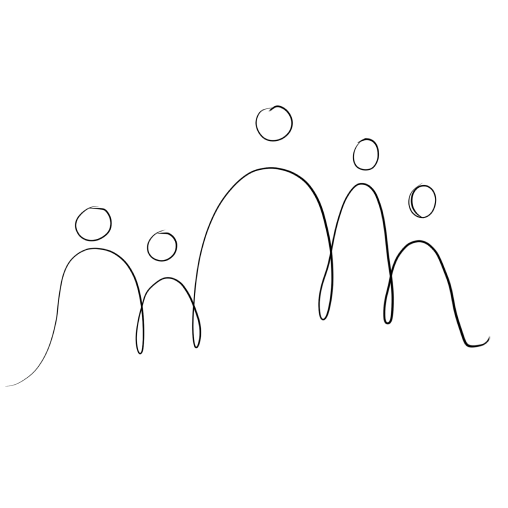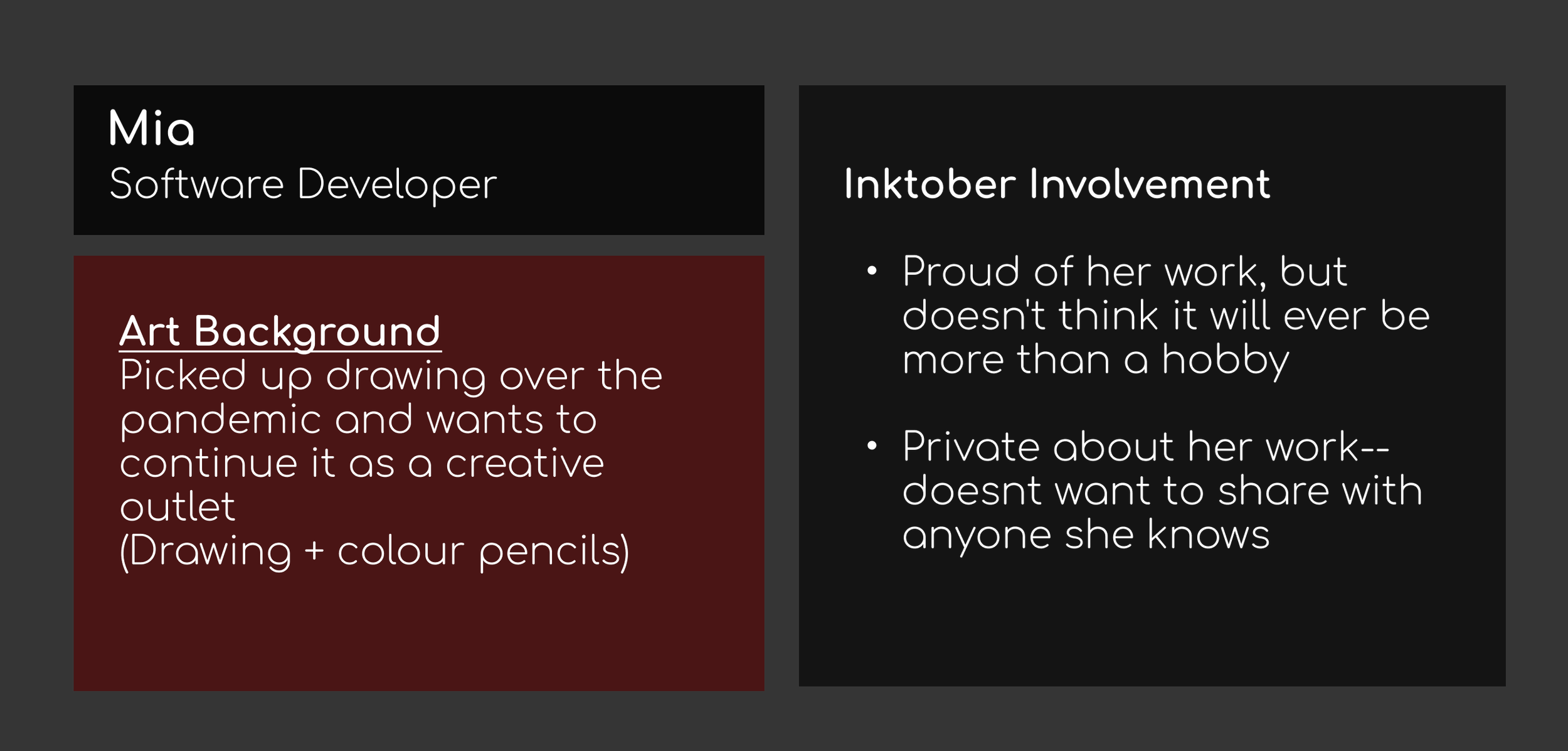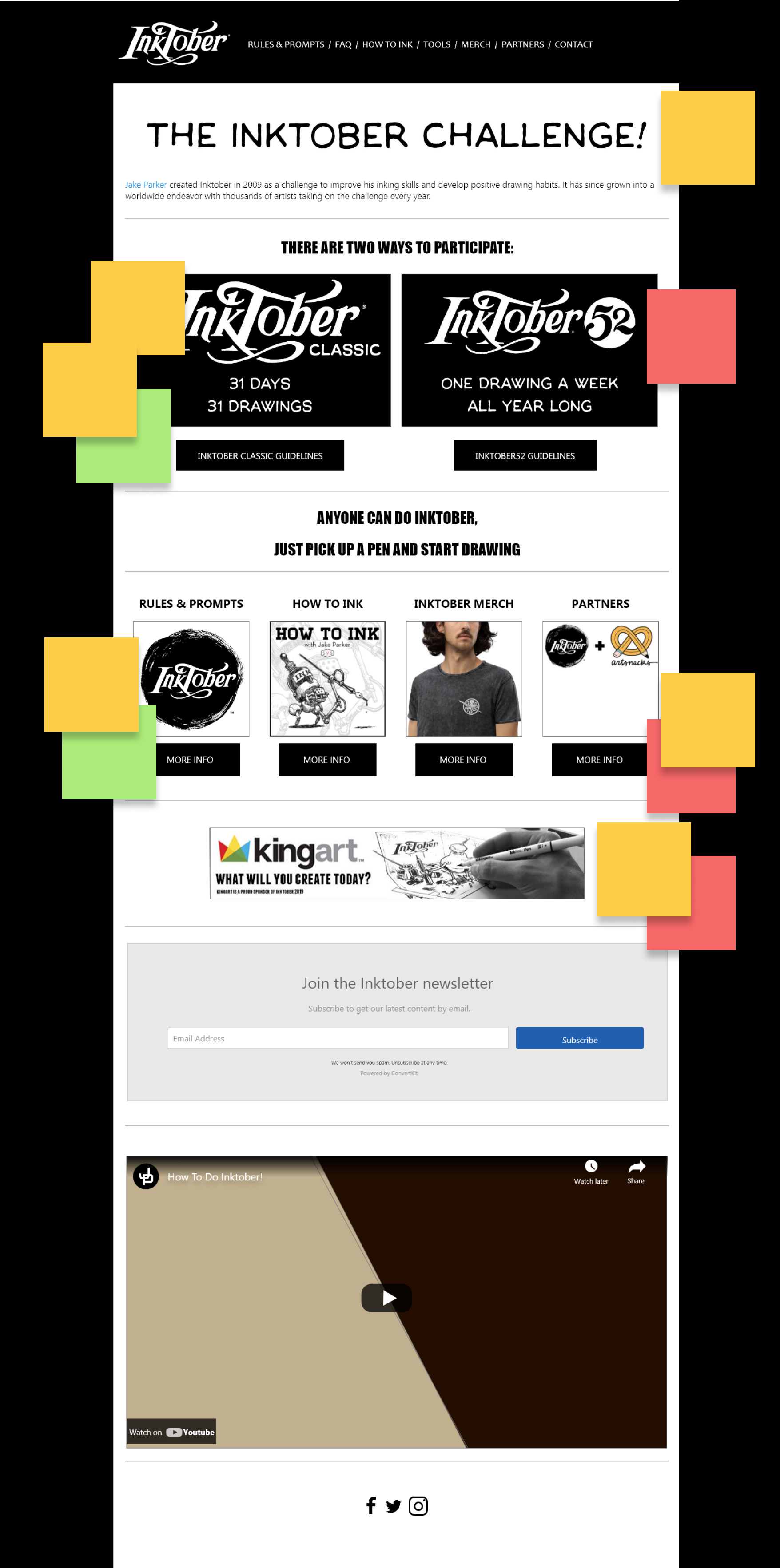Understanding the Audience
User Interview
A structured user interaction conducted so as to feel informal. questions are planned ahead of time and sessions are recorded wherever possible for future reference.
Recording sessions allows me to stay in the moment, especially when I don’t have a note taker, and pay attention to the non-verbal cues and subtext behind the interviewee’s responses.
User interviews are the basis on which I build personas for a given project
Inktober Persona 1
Inktober Persona 2
User Testing
User testing involves taking stock of exactly what needs to be learned about a design. Research questions are documented, and from there, a test plan can be written.
When time allows, my test plans catalog a detailed structure including clear cut exercises and a full script to maintain consistency across participants. When less time is available for preparation (as in the case of a Design Sprint or other forms of rapid prototyping), I opt to forgo some amount of rigidity in favour of opening the discussion to invite more exploration of idea tracks that I may not have had the opportunity to anticipate.
User Workshop
The goal of a user workshop is to explore the perspective of the end users. Workshops are meant to dive past the apparent and coax contextual information from individuals who may not have the practiced awareness or technical language to unpack their experience on their own.
Larger workshops, 10+ participants, can benefit from being broken down into smaller groups for activities. Those groups are to be lead by facilitators that have been chosen ahead of time. (This makes it very important to verify RSVP’s as accurately as possible so that I can plan for breakout groups and prep the most appropriate number of facilitators)
Problem Statement
The Inktober website is dense and very disconnected from the activity it details. Moreover, the webpage is static and not well suited to viewing on mobile devices.
Prep Work
I plan user workshops following a similar format as that used for Designs Sprints. Activities are meant to uncover and analyze the conscious and subconscious feelings that are experienced by those involved during a given task or process. Visuals go a long way in helping to guide the workshop process.
In preparation for this project, I spent time collecting imagery from the Inktober webpage and refamiliarizing myself with the rules and event structure.
“Jake Parker created Inktober in 2009 as a challenge to improve his inking skills and develop positive drawing habits. It has since grown into a worldwide endeavor with thousands of artists taking on the challenge every year.”
Inktober Rules
1) Make a drawing in ink (you can do a pencil under-drawing if you want).
2) Post it
3) Hashtag it
4) Repeat"
Classic Route
"you can do it daily, or go the half-marathon route and post every other day, or just do the 5K and post once a week. What ever you decide, just be consistent with it. Inktober is about growing and improving and forming positive habits, so the more you’re consistent the better."
52 Route
"1 prompt a week, 52 weeks in a year, 52 drawings"
Storyboarding
I begin workshops by walking the group through a visual representation of my understanding of their experience, and inviting dialogue to confirm or correct my assumptions.
Any alterations to the process are noted on a stickies and placed along the the diagram
Ahead of the workshop, I drafted a list of expected user types and designated a coloured sticky designated for each demographic
Establishing signifiers like this makes for easy scannability when it comes to understanding the context behind each comment, as well as keeping track of who might be a good initial point of contact for any follow up questions.
In the case of workshops, stickies are pre-assigned based on group to accommodate for larger participant counts.
Identifying Issues
In this case, because the user process was so simplistic, identifying issues within the experience was lumped into this step
Some notable callouts from the session included:
Lots of extraneous pages
Pretty wordy
Not interactive
Cool record of past events
External Inspiration
This stage is an opportunity for participants to find examples of other products that solve the issues outlined in the last stage. The idea is to collect screenshots from other platforms as visual aids supporting possible solution avenues.
Each visual should be accompanied by the name of the platform it was pulled from and some bullets explaining what elements of the suggestion the participants would like to emulate.
I encourage participants to branch out into unrelated industries.
Pulling from apps and websites that they use in their daily lives can be a good place to have them start. There’s a reason that they gravitate toward those in the first place and there may be universal elements that can be drawn on.
Rapid Prototyping
In between workshop session, I would meet with facilitators as necessary to gather an understanding of the sentiments that accompanied the comments from each group, organize the discussion points and stickies into informal design requirements to guide my prototyping.
The purpose these outputs serve is focused less on direct implementation and more so on creating a visual checkpoint with participants. These designs are a chance to check in with workshop participants, and summarize my takeaways and projected design plan moving forward. I started by creating a style guide to give the app a cohesive look and feel.
Component libraries
Design Review
During the design review, participants have the opportunity to assess the developments in my understanding of their perspective and directly impact the direction of the project.
Here, participants are invited to explore and comment on the preliminary sketches. I listen to their feedback with a view to understanding what portions of the concept are on the right track, what parts may need to be reimagined, and what might be missing entirely.
Once again, stickies are placed directly on the part of the sketch being referenced in the comment.
Share Findings and Follow-ups
Following up is important not only for keeping up users’ engagement with the process for future learning sessions, but also for maintaining their trust in me and my team’s continued effort and ability to deliver exciting and effective experiences.














